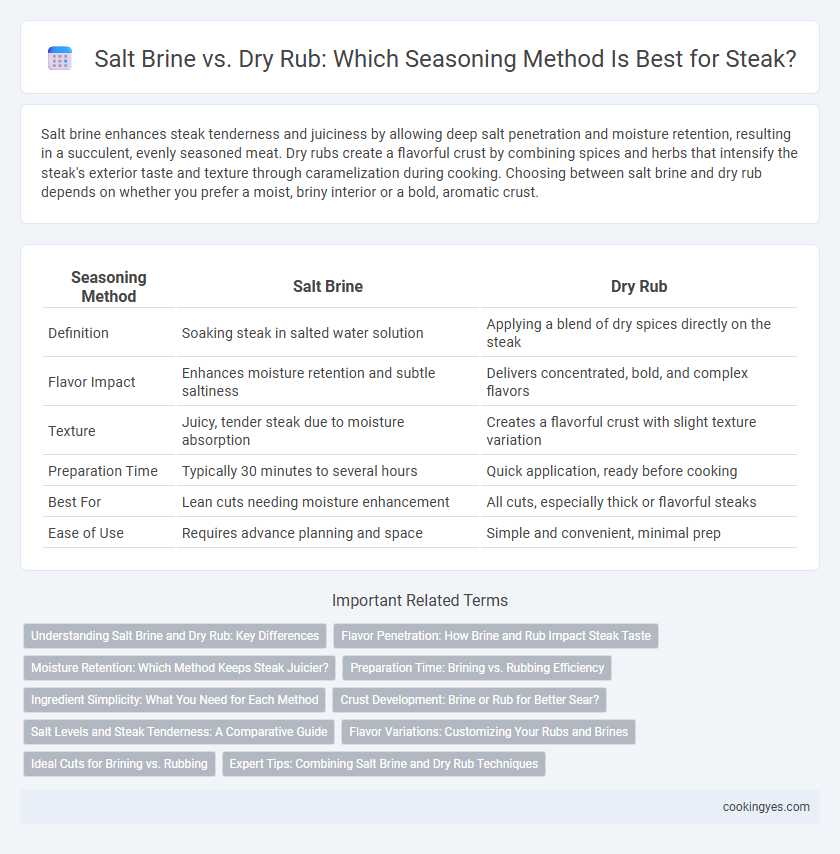Salt brine enhances steak tenderness and juiciness by allowing deep salt penetration and moisture retention, resulting in a succulent, evenly seasoned meat. Dry rubs create a flavorful crust by combining spices and herbs that intensify the steak's exterior taste and texture through caramelization during cooking. Choosing between salt brine and dry rub depends on whether you prefer a moist, briny interior or a bold, aromatic crust.
Table of Comparison
| Seasoning Method | Salt Brine | Dry Rub |
|---|---|---|
| Definition | Soaking steak in salted water solution | Applying a blend of dry spices directly on the steak |
| Flavor Impact | Enhances moisture retention and subtle saltiness | Delivers concentrated, bold, and complex flavors |
| Texture | Juicy, tender steak due to moisture absorption | Creates a flavorful crust with slight texture variation |
| Preparation Time | Typically 30 minutes to several hours | Quick application, ready before cooking |
| Best For | Lean cuts needing moisture enhancement | All cuts, especially thick or flavorful steaks |
| Ease of Use | Requires advance planning and space | Simple and convenient, minimal prep |
Understanding Salt Brine and Dry Rub: Key Differences
Salt brine involves soaking steak in a saltwater solution, which enhances moisture retention and results in a juicier texture by allowing the salt to penetrate deeply into the meat fibers. Dry rub seasoning, on the other hand, consists of a blend of salt, herbs, and spices that coats the steak's surface, creating a flavorful crust during cooking without changing the internal moisture content. Understanding these methods is crucial for choosing between enhanced juiciness with salt brining and concentrated exterior flavor with dry rubs when seasoning steak.
Flavor Penetration: How Brine and Rub Impact Steak Taste
Salt brine enhances flavor penetration in steak by allowing salt and seasoning to diffuse deeply into the meat fibers, resulting in a juicier, more uniformly seasoned bite. Dry rubs primarily coat the surface, creating a flavorful crust through caramelization during cooking, but their impact is mostly limited to the steak's exterior. The choice between brine and rub influences whether the seasoning flavor is distributed internally or concentrated on the steak's surface texture.
Moisture Retention: Which Method Keeps Steak Juicier?
Salt brine enhances moisture retention in steak by allowing salt to penetrate the meat, breaking down muscle fibers and increasing water absorption, resulting in a juicier final product. Dry rubs, while rich in flavor, do not significantly improve moisture retention and can sometimes draw moisture out of the steak's surface. Research consistently shows that brining outperforms dry rubs in maintaining juiciness during cooking.
Preparation Time: Brining vs. Rubbing Efficiency
Salt brining steak involves soaking the meat in a saline solution for several hours, allowing deep muscle penetration that enhances juiciness and flavor. Dry rubbing requires minimal preparation time, as the spice mix is applied directly before cooking, offering a faster seasoning method. While brining optimizes moisture retention through extended marination, dry rubs provide efficient flavor enhancement with immediate application.
Ingredient Simplicity: What You Need for Each Method
Salt brine requires only water, salt, and sometimes sugar, allowing the meat to absorb moisture and season evenly for enhanced juiciness and flavor. Dry rub involves a blend of salt, spices, and herbs, offering a concentrated seasoning that creates a flavorful crust on the steak's surface. Both methods prioritize simple ingredients but differ in preparation: salt brine relies on immersion while dry rub depends on coating.
Crust Development: Brine or Rub for Better Sear?
Salt brine enhances crust development by penetrating the steak, increasing moisture retention and promoting Maillard reaction during searing for a juicier interior and crispy outer layer. Dry rubs, rich in spices and herbs, create a flavorful, textured crust through direct application, intensifying browning and aroma without added moisture. For optimal sear and crust, combining a brief salt brine with a dry rub maximizes moisture control and flavor concentration.
Salt Levels and Steak Tenderness: A Comparative Guide
Salt brine enhances steak tenderness by penetrating muscle fibers and retaining moisture, resulting in juicier meat with balanced salt levels. Dry rub seasoning provides a concentrated salt layer on the surface, creating a flavorful crust but less internal salt absorption. Optimizing salt levels through brining improves tenderness, while dry rubs emphasize texture and flavor intensity without significantly affecting internal moisture.
Flavor Variations: Customizing Your Rubs and Brines
Salt brine infuses steak with deep moisture and subtle saltiness, enhancing juiciness while allowing flavor variations through added herbs, spices, and aromatics like garlic or rosemary. Dry rubs offer concentrated flavor layers by combining coarse salt with smoked paprika, cumin, brown sugar, or chili powder, creating diverse taste profiles from smoky to sweet and spicy. Customizing brines and rubs tailors intensity and complexity, letting you balance saltiness, sweetness, heat, and herbal notes to elevate each steak's unique flavor experience.
Ideal Cuts for Brining vs. Rubbing
Tender cuts like ribeye and filet mignon benefit from dry rub seasoning, enhancing their natural flavors without drawing out moisture. Tougher cuts such as brisket, flank, and chuck respond best to salt brine, which tenderizes the meat and improves juiciness through moisture retention. Choosing the right method depends on the cut's texture and desired flavor profile, optimizing both taste and tenderness.
Expert Tips: Combining Salt Brine and Dry Rub Techniques
Expert tips for seasoning steak emphasize combining salt brine and dry rub techniques to enhance flavor depth and tenderness. Soaking steak in a salt brine for 30-60 minutes ensures moisture retention and even seasoning, while applying a dry rub with spices and herbs creates a flavorful crust during cooking. This dual approach maximizes juiciness and complexity, delivering a perfectly seasoned and richly flavored steak.
Salt brine vs Dry rub for seasoning Infographic

 cookingyes.com
cookingyes.com